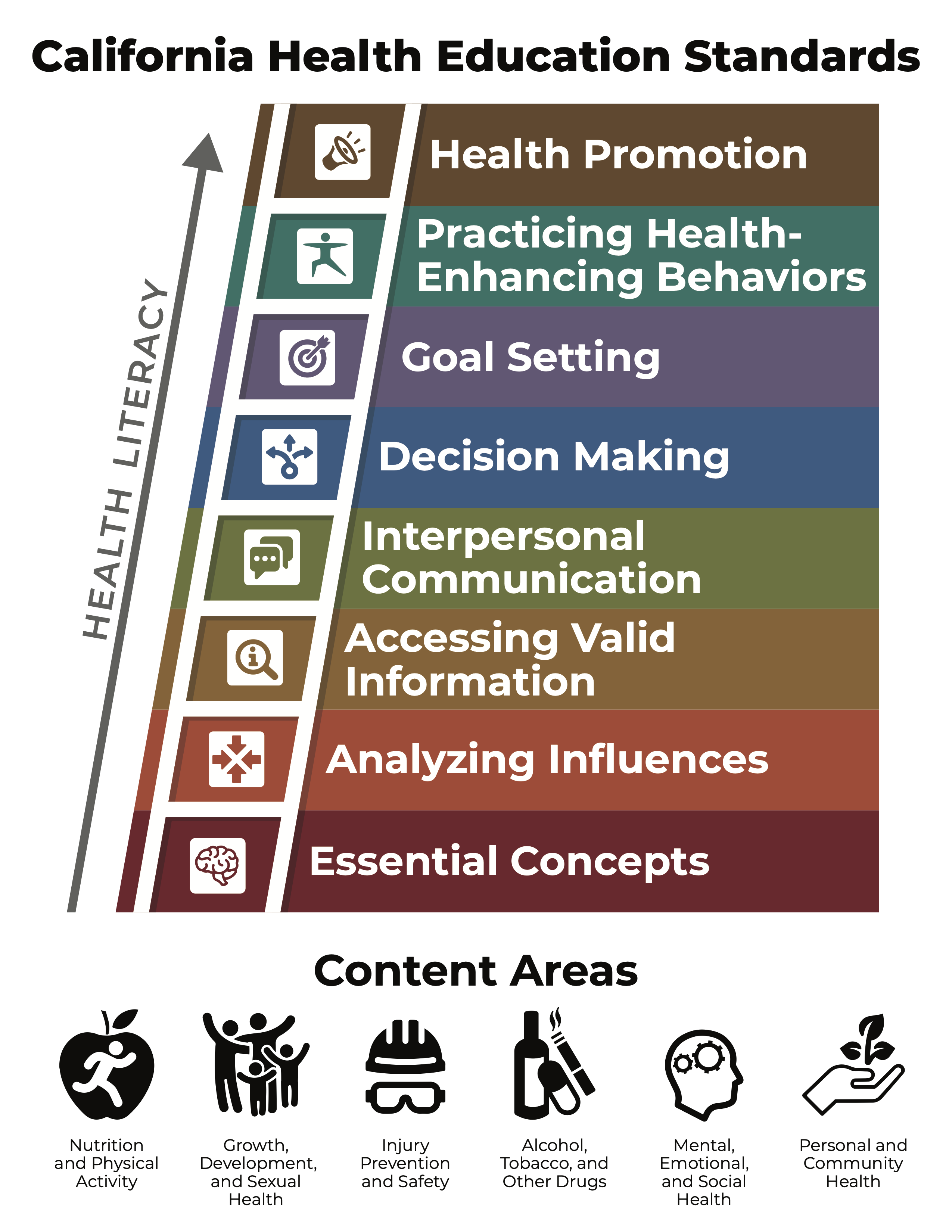Welcome to the CA Health Education Framework Administrator and Leadership Professional Learning Section 4: Curriculum and Instruction. This Section provides an overview of the relationship between the CA Health Education Standards, Content Areas and Framework support for shifts in health education instructional planning and delivery, student Access and Equity through health education curriculum and instruction, strategies like UDL and SEL to enhance curriculum and instruction, and, new Framework-based Health Education Standards Guides and Lesson Planning Tools.
 Learning Outcomes for Section 4
Learning Outcomes for Section 4
Participant learning outcomes for Section 4:
- See and hear about shifts in skills-based Health Education curriculum and instruction
- Describe some benefits of these shifts for all students, especially health and academic at-risk sub-populations
- View Health Ed Curriculum and Instruction through the lens of Access and Equity
- List some key strategies and characteristics of an effective Health Education curriculum
- Identify Health Education Standard Guides and Lesson Planning tools and resources to share with teachers
- Reflect on next steps in application of the learning
1. Shift in Health Education
[WATCH] (11 min)
“This is not your parents health ed class” - Andy Milne, National TOY TED Talk - Hear how shift to skills-based transforms learning
2.Connecting Health Standards and Content Areas to Health Literacy
[READ] (2 min)

The eight overarching CA Health Education Standards identify key knowledge and skills students need to build Health Literacy needed as an adult.
Health Education Standards describe what a student should “know and be able to do” in each Content Area, at each grade level.
3. Planning for Access & Equity Informs Skills-Based Instruction and Drives Curriculum Choices
[READ] (5 min) While we hear a lot about Access and Equity in public schools, achieving access and equity occurs by administrators:
- Knowing and supporting all student populations by using data about the student population and understanding of their needs
- Using CHKS student health data tools to explore and raise awareness of needs and gaps faced by at-risk students
- Developing and implementing instructional strategies that increase access and equity
- Recognizing and utilizing assets of at-risk student subpopulations within the Health Education program
- Supporting ongoing teacher collaboration and professional learning about these concerns
- Measuring the impact student behavioral health has on school climate and culture
- Choosing and using curriculum that actively reflects and supports these basic principles helps insure student Access and Equity
-
Diversity in student culture, language, and identities
-
Inclusiveness: All people are represented
-
All people are shown in a positive light
Health Education Curriculum that supports Access and Equity meets these criteria:
- Features skills-based units and lesson plans across curriculum
- Includes
Universal Design for Learning (UDL) strategies
- Is relevant, current, and medically accurate
- Is age and developmentally appropriate
Culturally & Linguistically Responsive Teaching and Curriculum
Let’s take a closer look at what it means to be a Culturally and Linguistically Responsive curriculum. Curriculum defines student diversity as an asset and helps create a safe and inclusive learning environment by ensuring that all students are included, validated, and valued.
In order to create truly equitable classrooms, schools, and districts that support all students’ achieving success - teachers and all school staff continuously strive for social justice, access, and equity.
Six essential practices for culturally responsive teaching is based on Framework guidance meant to support teachers in creating safe and supportive learning environments as well as ensuring cultural and linguistic responsiveness.
Curriculum Maps: Guiding Access and Equity
[WATCH] (7 min 21sec) :Characteristics of an Effective Health Education Curriculum - CDC
As you watch the CDC video below, you might think about...
- What evidence of the characteristics do you see in your program?
- How you might address missing or under-developed elements
- What additional resources might be needed to improve student health learning outcome
4. New Instructional Resources
[READ] (1min)
Within the Framework goal of supporting teachers and school leaders in making the shift to standards-based health education, additional resources have been developed. These new resources are centered on supporting teachers in shifting their lesson design to include more skill building standards and standards-aligned assessment tools.
- Standard Guides
- Skills Posters
- Model Learning Activities (examples of standards based instruction design)
5. Health Education's Role in MTSS
[READ] (8 min)
The CA Multi-Tiered System of Support (MTSS) is another CA-sponsored health-related initiative:
- California's Multi-Tiered System of Support (MTSS) is a comprehensive framework that aligns with academic, behavioral, and social-emotional learning outcomes
- Skills-based Health Education is a key component of any fully integrated system of student support and engagement
- Health Education includes evidence and skills-based curriculum and instruction that leverages and improves student behavioral health and SEL outcomes
Health Education can become a key universal intervention in a MTSS
continuum of support as part of a fully integrated
system of engagement because it includes the evidence and skills-based curriculum and instruction that leverage and improve student behavioral health and SEL outcomes.
Benefits of using Health Education as a MTSS Universal Intervention strategy:
- Combining multiple State and Federal mandated curriculum in a Comprehensive Health Education course of study leverages human and fiscal resources
- Integrating the teacher staffing and time associated with multiple stand-alone health-related initiatives in a K-12 Health Education Program reduces costs and improves student health and wellness learning outcomes - especially for student populations at-risk for health-related academic disparities
- This integration strategy increases consistency and continuity of overall K-12 Health Education instruction program introducing equity and access to skills-based Health Education teaching and student learning across all grade levels
- As student Health Education learning is scaffolded and supported across grade levels, student access to learning and equity of instructional quality and outcomes improve student health literacy outcomes across the school and district
 Self-Reflection Questions
Self-Reflection Questions
What are three new things you learned about Health Education curriculum and instruction in this Module?
What is one way a skills-based Health Education instructional program might help solve access and equity issues at your school, or in your district?
What two tasks related to Health Ed curriculum and instruction will you take action on immediately?
